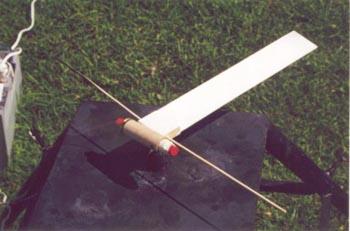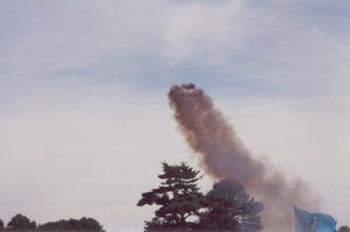| Construction Rating: | starstarstarstarstar |
| Flight Rating: | starstarstarstarstar_border |
| Overall Rating: | starstarstarstarstar_border |
| Manufacturer: | J.A.P. Systems |
Brief: This is the 24mm version of Joseph Peklicz's monocopter rocket. He has a 18mm version, but I wanted the 24mm since there are a variety of long burning motors available in 24mm format.
This is the 24mm version of Joseph Peklicz's monocopter rocket. He has a 18mm version, but I wanted the 24mm since there are a variety of long burning motors available in 24mm format.
Construction:
All the parts came is a thin plastic bag. All the components where there, and they were pre-shaped, and pre cut. The single balsa blade is pre-coated with paper. This adds strength without the additional weight. Instructions are hand drawn on a single sheet of paper.
Construction was quick since everything except the gluing was done for you. Gluing the motor tube to the center hub was the most time consuming process. This is the most critical part of the kit, since the force of the motor will try to rip the motor tube off of the hub. I decided to use wood glue for this task. I did not want the extra weight of epoxy. I did one modification to my monocopter: I did not install the cardboard bulkhead that is placed against the thrust ring. I decided that I wanted to use an RMS case, and that bulkhead would get in the way of casing's forward closure.
Finishing:
To save weight, I did not paint my monocopter. The paper on the wing is a convenient place to mark the monocopter with a Sharpie pen in case you want to add a personal touch.
Construction Rating: 5 out of 5
 Flight:
Flight:
Flights with a D motor are very low. I'd say that mine got about 30 ft with a D12-0. For the second flight, I used a E11-3J reload. Much better. The monocopter went up about 60ft. At the August 18th, 2001 CMASS launch, I launched my monocopter with a F12-3J. It flew fine, but on the way down, the wing hit the rope fence around the pads. The monocopter's wing was shattered beyond repair.
Recovery:
I think my monocopter was not balanced. The reason I say this it wandered in one direction. It would probably go higher if the monocopter did not wander around in the sky.
Flight Rating: 4 out of 5
Summary:
This is a well executed kit. I liked the way everything was pretty much done for you. Flights are interesting and unique. This rocket is well worth the purchase.
Overall Rating: 4 out of 5
The following excerpt is from "Sport Rocketry". The intention is to allow guests to get a basic feeling about a kit. We strongly suggest that you get a copy of the referenced Sport Rocketry and read the entire article. Inside you will find many helpful hints in construction as well as other useful information. For more information, use the two links above.
(Sport Rocketry - May/June 2001 - page 32 - by Mort Binstock)
"A monocopter is a one-blade helicopter, similar in appearance to a maple seed.>
"...a D-monocopter appears limited to a 40-60 foot boost"
"Assembly of the "D"izzy is quick and easy."
"The instructions are simple and clear."
"The wing is a paper-covered balsa core laminate."
"The recommended motor is a D12-5 or -7."
"My first flight using a D12-7 was a disaster: the main blade broke off and parts shredded everywhere... Subsequent inspection revealed the damage was not severe and the model was quickly repaired with CA."
"Subsequent launches were made from the top of ...three foot long 1/8" steel launch rod...."
"My second "D"izzy launch was most rewarding. The repaired "D"izzy flew powered by a D12-5. Lift off was unusual and spectacular to watch (look at it go!) with an estimated 50 ft. altitude."
"The monocopter... ascended with a quick and straight boost. The monocopter then descended slowly, experiencing no further damage."
The article also provides a brief history of monocopters. The kit provides for a different launch and recovery than typical rocket kits.
 |
 |
![[NAR]](images/archive/images/link_nartitle.gif)
![[Sport Rocketry]](images/archive/images/link_sr_logo.gif)